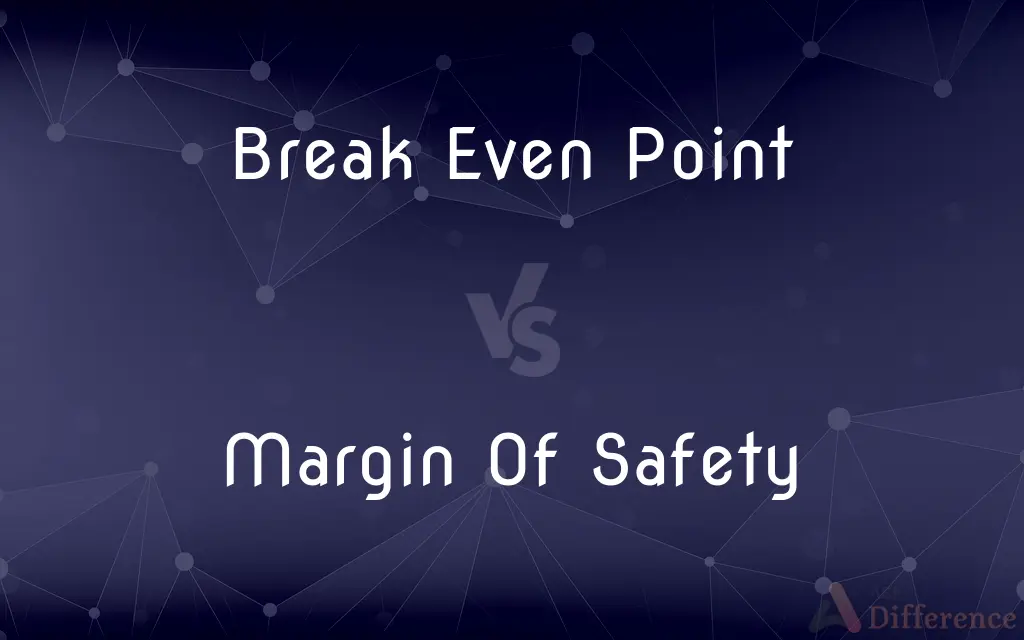Break Even Point vs. Margin Of Safety — What's the Difference?
By Tayyaba Rehman — Published on October 5, 2023
Break Even Point is when total costs equal total revenue, incurring no profit or loss, whereas Margin Of Safety is the difference between actual or expected sales and sales at the break-even point, measuring risk level.

Difference Between Break Even Point and Margin Of Safety
Table of Contents
ADVERTISEMENT
Key Differences
Break Even Point and Margin Of Safety are pivotal concepts in financial analysis and business strategy. The Break Even Point is the point at which total revenue equals total costs, meaning the business neither makes a profit nor incurs a loss. It is a critical metric for understanding the level of output or sales that a company needs to achieve to cover its costs. Determining the Break Even Point helps businesses in pricing, cost control, and operational efficiency, ensuring sustainability.
Conversely, the Margin Of Safety represents the difference between the actual or expected sales and the sales at the Break Even Point. It quantifies the cushion or buffer that a company has before it incurs a loss, acting as an indicator of the risk level associated with the company’s operations. A higher Margin Of Safety implies lower risk, reflecting either higher sales or lower costs, enabling businesses to withstand fluctuations in market demand or cost structures.
While the Break Even Point focuses on achieving a balance between revenues and costs, the Margin Of Safety is concerned with the extent to which a company can experience a drop in sales before it starts incurring losses. The Break Even Point provides insights into the minimum performance required to avoid losses, guiding cost management and pricing strategies. The Margin Of Safety, however, offers a perspective on business resilience and financial stability, informing risk management and strategic planning.
Understanding and effectively utilizing both the Break Even Point and the Margin Of Safety is essential for business success. The Break Even Point assists in setting sales targets and controlling costs, contributing to operational optimization. Meanwhile, the Margin Of Safety aids in evaluating business risks and profitability potential, allowing for informed decision-making and proactive management. The integration of these concepts is crucial for achieving a balanced and resilient business model, optimizing both risk and return.
Comparison Chart
Definition
Point where total revenue equals total costs.
Difference between actual or expected sales and sales at the break-even point.
ADVERTISEMENT
Purpose
To identify the level of sales or output needed to cover costs.
To measure the risk level and financial stability of a business.
Focus
Achieving a balance between revenues and costs.
Assessing the cushion a company has before it incurs a loss.
Implication
Guides pricing, cost control, and operational efficiency.
Informs risk management, strategic planning, and decision-making.
Impact on Business Strategy
Helps in setting sales targets and managing costs.
Aids in evaluating and managing business risks and profitability potential.
Compare with Definitions
Break Even Point
Break Even Point helps set realistic sales targets.
Establishing a clear Break Even Point allowed the team to set attainable sales goals.
Margin Of Safety
Margin Of Safety is an indicator of financial stability.
The company’s substantial Margin Of Safety revealed its strong financial position and resilience to market changes.
Break Even Point
Break Even Point aids in pricing and cost control strategies.
Knowing the Break Even Point helps in optimizing pricing to cover all associated costs effectively.
Margin Of Safety
Margin Of Safety aids in evaluating profitability potential.
By maximizing the Margin Of Safety, businesses can enhance their potential for increased profitability.
Break Even Point
Break Even Point is pivotal for operational efficiency.
Achieving the Break Even Point is a first step toward operational profitability and sustainability.
Margin Of Safety
Margin Of Safety measures the difference between actual sales and break-even sales.
A high Margin Of Safety indicates lower business risk and higher flexibility in operations.
Break Even Point
Break Even Point is where total revenue equals total costs.
The company’s new product reached its Break Even Point within the first six months of launch.
Margin Of Safety
Margin Of Safety informs strategic business decisions.
A thorough analysis of Margin Of Safety supports sound business strategy and proactive risk management.
Break Even Point
Break Even Point denotes no profit, no loss situation.
Calculating the Break Even Point is crucial for determining the minimum sales required to avoid losses.
Margin Of Safety
Margin Of Safety assesses the risk level of business operations.
Evaluating the Margin Of Safety is crucial for understanding the business’s ability to withstand sales fluctuations.
Common Curiosities
What does the Break Even Point represent in business?
It represents the point where total costs equal total revenue, resulting in neither profit nor loss.
Does the Break Even Point aid in pricing strategies?
Yes, knowing the Break Even Point helps in setting prices that cover all costs and potentially yield profits.
What is the significance of the Margin Of Safety?
It indicates the risk level of business operations by measuring the buffer before a business starts incurring losses.
Is achieving the Break Even Point crucial for business sustainability?
Yes, reaching the Break Even Point is essential for covering costs and achieving operational sustainability.
Is a higher Margin Of Safety better for a business?
Yes, a higher Margin Of Safety implies lower business risk and greater financial stability.
Can the Margin Of Safety inform risk management strategies?
Absolutely, it is a crucial metric for assessing and managing the risk level associated with business operations.
How is the Break Even Point calculated?
It is calculated by dividing total fixed costs by the contribution margin per unit.
Share Your Discovery

Previous Comparison
Unemployed vs. Underemployed
Next Comparison
Insurrection vs. InsubordinationAuthor Spotlight
Written by
Tayyaba RehmanTayyaba Rehman is a distinguished writer, currently serving as a primary contributor to askdifference.com. As a researcher in semantics and etymology, Tayyaba's passion for the complexity of languages and their distinctions has found a perfect home on the platform. Tayyaba delves into the intricacies of language, distinguishing between commonly confused words and phrases, thereby providing clarity for readers worldwide.
















































